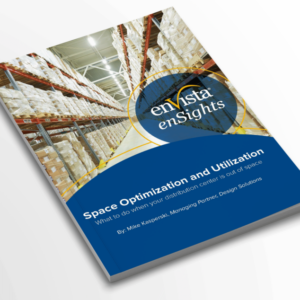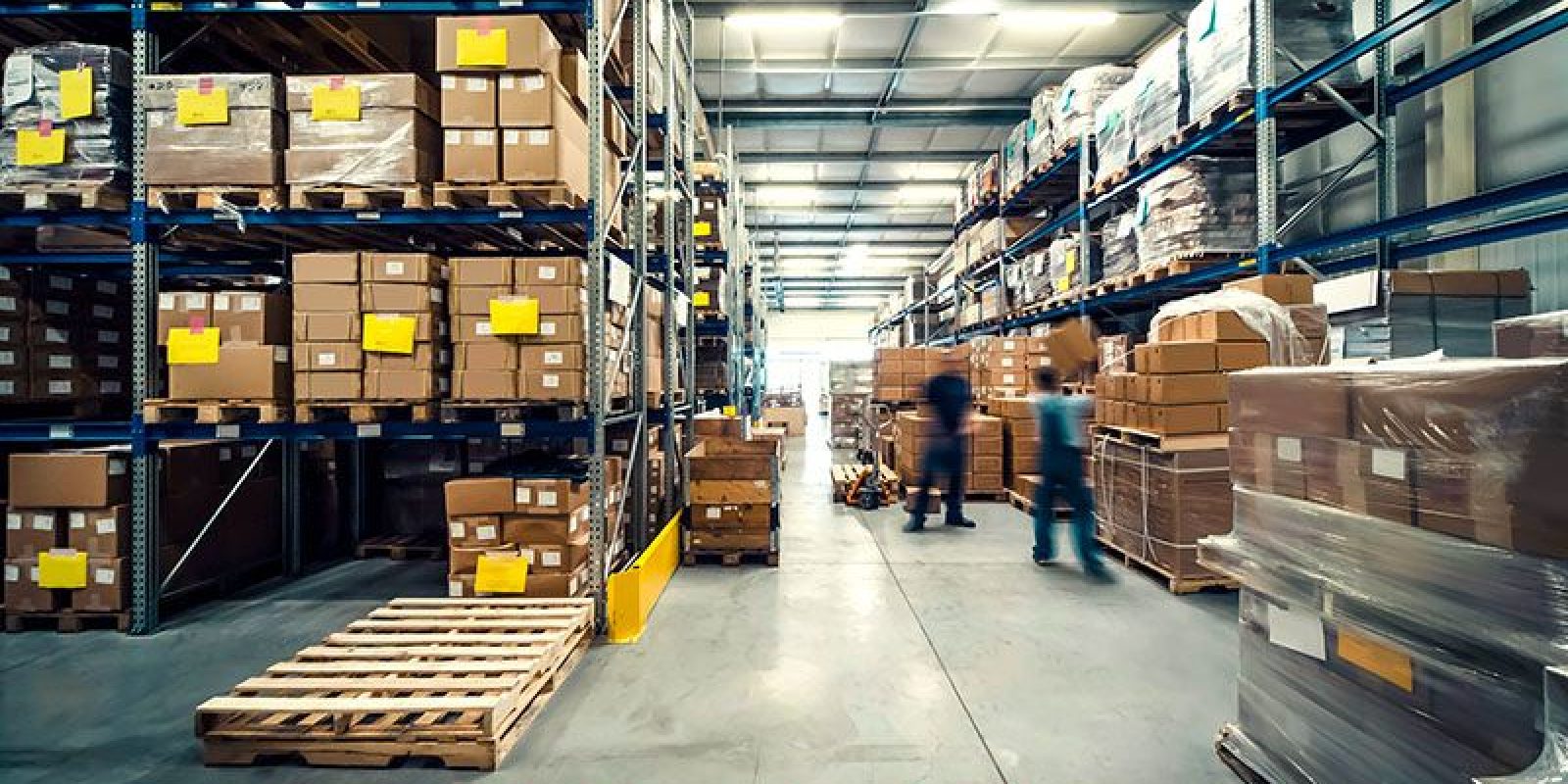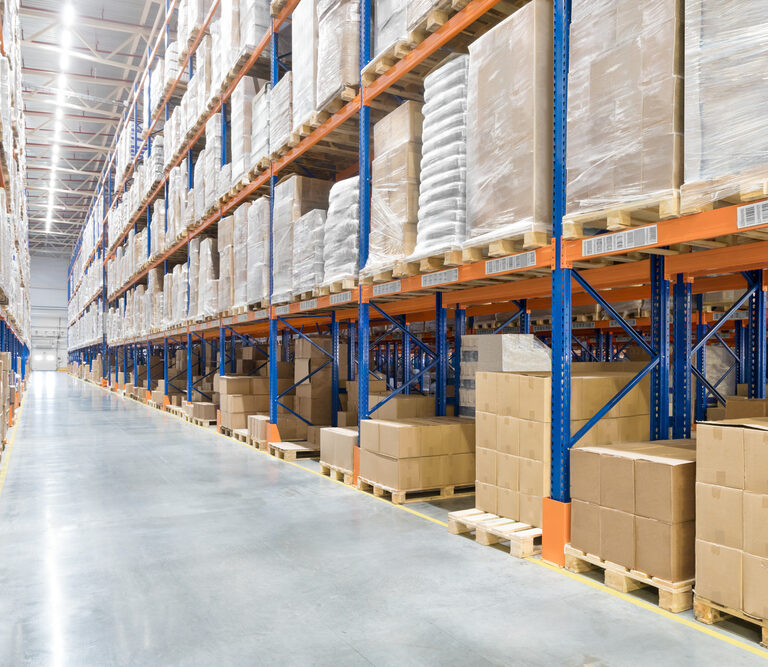Optimizing inventory in your warehouse or distribution center is one of many challenges you face along the supply chain, and a primary challenge of inventory management in distribution centers (DC) is limited space. A distribution center is technically out of space when it hits about 85 percent of its occupancy. That’s not just in the warehouse storage area; it holds true for receiving, shipping and all other process areas.
The biggest problem when a distribution center exceeds 85 percent occupancy is congestion. Congestion causes extra work – meaning extra work by moving product that you don’t have room for. You have to move “Product A” into another location in order to take this other “Product B” out. You start to store stuff in aisles. You use staging space that’s typically free space for new incoming material. Think of your warehouse’s storage as a three-car garage. If you put all three cars in a three-car garage, you have no room for lawnmowers, snow blowers or yard tools, and you have to move a car out in order for them to fit. The same thing happens in a distribution center. If it’s jam-packed full, you’re typically moving inventory in and out, and you’re taking up valuable time and additional labor.
Why Warehouses & Distribution Centers Run Out of Space
There are several reasons why warehouses run out of space. Some are good problems to have while others are inventory problems.
- Business is booming. Products are hot – they’re selling. People are buying the product quickly, so you need more.
- The purchasing department overbuys something. When planning the DC, you decide you only need two months of inventory, but purchasing gets a great deal on something and buys six months instead. Where are you going to put this?
- Another reason is obsolete or dead inventory – inventory that doesn’t move and has been there for more than several seasons. If you run your finger over a product and it’s full of dust, the product has been sitting there too long. It should be moved somewhere in a less-congested spot, a less-congested picking area, or it should be destroyed and moved out of the building.
If you run out of space for inventory in your DC for any reason, there are several ways to increase capacity without the need for expansion.
How to Maximize Warehouse Storage Space Utilization
1. Evaluate your vertical space utilization to optimize warehouse space
Extending racks up is usually the “lowest hanging fruit” to create more warehouse storage space. Typically, new buildings have ESFR which is a fire suppression sprinkler system, and you can store inventory within 18 inches of that area. There are some pitfalls of rack extension – the racking uprights or base plates may not be sized properly. In that case, a structural engineer and a PE can confirm that rack extension is a viable option.
Types of Warehouse Storage Racks
One challenge to extending racks when optimizing warehouse space is finding the best kind of storage racks for the warehouse. Here are some of the more popular types of warehouse storage racks for your warehouse utilization:
- Pallet Racks: Depending on your industry, chances are your warehouse is already full of pallet racks. Using these basic racks, combined with a forklift and pallets, is one of the best ways to maximize your storage space if you have a variety of inventory types.
- Carton Flow Racks: These racks are ideal for FIFO (first in, first out) inventory processes. Carton flow racks have slanted panels that push down the older inventory so it’s more easily accessible.
- Cantilever Racks: Cantilever racking is great for long inventory like piping, lumber, or steel trusses. These racks have protruding arms where inventory gets placed. When extending these racks, take special care to consider if your employees will need extra equipment to reach higher levels of inventory.
- Mezzanines: A mezzanine is a platform that extends storage space to a second level above your warehouse floor. Mezzanines are another secret weapon for warehouse space utilization.
One of the best ways to increase warehouse capacity is to add a mezzanine. Installing a mezzanine above a floor-level process, like a shipping or receiving area, can nearly double floor space. Of course, there are pitfalls with a mezzanine as well. The floor loading must be able to handle it. There will be columns and base plates that now drop down to the floor that could be in the way of the process that’s below it, but it is much better to add a mezzanine, if possible, than to expand the building.
2. Reduce aisle width in the racking area
A wide aisle can range from 10 to 12 feet, but if that can be reduced to anywhere from five to eight feet, 15 to 20 percent of the area can be saved. When considering this option for warehouse space optimization, lift equipment must be evaluated. Is the equipment capable of following or working in those narrow aisles? There is also the added expense of wire guidance in a very narrow aisle situation.
3. Evaluate and change your storage medium
Another option for increasing warehouse capacity is to change the storage medium to higher-density equipment, moving from single-deep racking systems to double-deep racking systems for example. A double-deep rack requires a reach truck to load pallets. Push-back or drive-in racks are also higher-density equipment alternatives. These options are great for adding storage and optimizing warehouse space, but the problem becomes FIFO: first in, first out. Higher density limits accessibility to the first-in pallets.
4. Add half-pallet locations for product that comes in half-pallet quantities
Adding half-pallet locations can save space since some product comes in only a half-pallet quantity. We see that as fluid volume as opposed to just what’s in that area. If you condense your pallets, you can put more pallets, and therefore more product, in the same area without too much white space.
5. Leverage your warehouse management system for directed put-away
Directed put-away is a great way of creating or saving space in a warehouse as well. It’s usually directed by your warehouse management system where instead of the put-away rules being just “put the pallet wherever you want”, directed put-away knows what locations are best suited for pallets. It tells you where to put a certain pallet as opposed to letting a worker put it in the most convenient location.
6. Identify underutilized space
Use space you never thought you had before. There’s often additional space above receiving or shipping doors where pallet racks full of supplies, slow-moving materials or staging for inbound or outbound product that hasn’t yet been processed can be placed. If there is a pick module in the facility and a conveyor down the center of the module, hang a shelf above the conveyor. It’s an easy way to increase storage capacity for smaller or slower-moving items that don’t need replenished as frequently. Those products will need to be replenished by hand or by the conveyor system.
7. Store product in trailers for short-term, seasonal needs
Finally, storing products in trailers is sometimes a necessary solution to temporary warehouse storage needs. Many warehouses will bring in extra trailers and pay the demurrage charge for temporary storage without a building expansion. This is frequent for seasonal product, especially among retailers.
Seasonal demand forecasting plays a crucial role in mitigating congestion by enabling businesses to anticipate fluctuations in demand and adjust their operations accordingly. By analyzing historical data and identifying seasonal trends, companies can better prepare for peak periods, ensuring that they have adequate inventory, staff and logistics capacity to handle increased demand. This approach helps to prevent bottlenecks in supply chains, reduce stock-outs or overstock situations and improve overall customer satisfaction. Effective seasonal forecasting also allows for more efficient scheduling of deliveries and workforce management, which can significantly alleviate congestion in distribution centers and transportation networks.
8. Utilize warehouse material handling equipment to your advantage
Leveraging warehouse material handling equipment effectively is essential to optimizing operations and staying competitive in an increasingly automated industry. Advanced material handling systems, such as automated guided vehicles (AGVs), conveyor systems and robotic picking solutions, can significantly enhance efficiency and accuracy in warehouse operations. By integrating these automated technologies into your workflow, you can reduce manual labor, minimize errors and increase throughput, especially during peak demand periods.
Automated storage and retrieval systems (AS/RS) allow for better space utilization, enabling higher storage density and faster access to goods. These systems also contribute to safer working environments by reducing the risk of injuries associated with manual material handling tasks.
There is No “One-Size Fits All” for Warehouse & Distribution Center Optimization
There is no one right answer to improve warehouse capacity and warehouse space utilization issues. In fact, the answer is usually a combination of several things. You can free up space, add equipment and add trucks to the yard. We still like to remember the 85 percent rule. Don’t cram product into 100 percent or even 90 percent. Remember that garage; you still want to be able to get the lawnmower out when you need to cut the grass.
For a third-party perspective on calculating warehouse capacity and getting the most out of your warehouse space utilization, explore our warehouse space optimization consulting solutions.
Need more in-detail to help you think through warehouse space optimization offline? Download our space optimization white paper and maximize warehouse space today. Let’s have a conversation® – contact enVista today.

Space Optimization and Utilization
Learn more about how you can focus on space optimization and utilization for your company from the experts at enVista.







